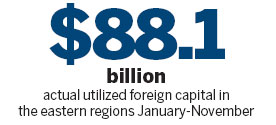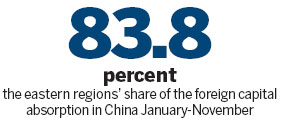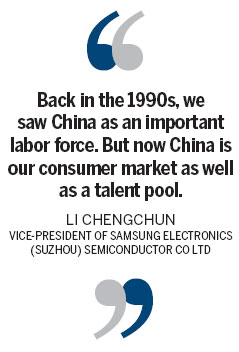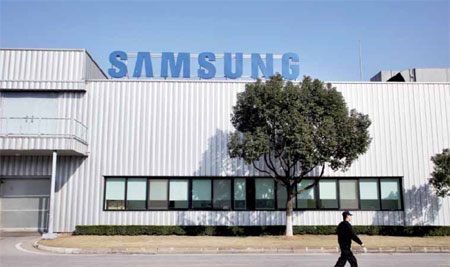Foreign firms still favor east side
Updated: 2013-12-20 10:05
By Li Jiabao (China Daily Europe)
|
|||||||||||
Developed industrial facilities and infrastructure give region an edge in attracting investment
Despite rising costs in recent years, China's eastern region remains a strong attraction for foreign investors, thanks to its well-developed industrial facilities and infrastructure, as well as easy access to the domestic market, businesspeople say.
"Back in the 1990s, we saw China as an important labor force. But now China is our consumer market as well as a talent pool," says Li Chengchun, vice-president of Samsung Electronics (Suzhou) Semiconductor Co Ltd.
"China remains our top investment destination, although we don't exclude the possibility of investment in Southeast Asia to take advantage of the labor force.

"As for high-end industries, China, especially the eastern region, still has great scope for development."
Business in the Chinese market has had the fastest growth in recent years among the South Korea-based electronic giant's major markets, he says.
At the same time, the Chinese government's move to raise household incomes has been unleashing consumer demand.
The Samsung factory was established in 1994 in Suzhou, Jiangsu province. Suzhou is about 80 km northwest of Shanghai, an economic hub connecting several cities via a network of highways and high-speed railways.
China was the world's second-largest recipient of foreign direct investment last year. Stable FDI inflows play an important part in the healthy development of the world's second-largest economy.
Non-financial FDI inflows in China fell 3.7 percent year-on-year to $111.7 billion last year, amid an 18 percent decrease in global FDI.

In the period January-November this year, non-financial FDI inflows to China rose 5.48 percent from a year earlier to $105.51 billion, says the Ministry of Commerce.
In the corresponding period this year, non-financial FDI in the eastern region rose 5.17 percent to $88.16 billion, about 83.8 percent of the country's total.
Foreign investment in the central region rose 9.52 percent to $9.2 billion, accounting for 8.7 percent of the total, while FDI in the western region rose 4.51 percent to $8.14 billion, making up 7.5 percent of the total.
European Trade Commissioner Karel De Gucht said on Oct 8 that the level of bilateral investment between the EU and China "is still far below what one would expect from two important economic blocs".

"Although the foreign direct investment flows from the EU to China are on the increase, they only represent 2.1 percent of total EU FDI outflows," he said. "The EU's share in the total FDI outflows from China also remains low, although the overall amount has increased strongly in recent years. Promoting bilateral investment should be the joint economic objective for the years ahead."
In the period January-November, China's FDI from the European Union rose 17.36 percent year-on-year to $6.82 billion. Germany's spending in China rose 43.74 percent to $2 billion and the investment from the Netherlands rose 10.63 percent to $1.2 billion, says the ministry.
On November 21, China and the EU agreed during an annual summit to negotiate a landmark bilateral investment treaty, which will offer both protection to existing and future investments and create new market access on both sides, thereby providing the impetus for increased two-way investment flows. Europe is China's most important trading partner, and for the EU, China is second only to the United States.
"In China, paper use is still growing, and that's expected to continue. Meanwhile, the paper business is decreasing in the European Union," says Timo Johansson, general manager of UPM (China) Co Ltd, the subsidiary of a Finnish paper maker, based in Changshu, Jiangsu province.
"We plan to increase investment in China. Our business in China serves the whole Asian market," Johansson says.
"Although labor costs are rising about 10 percent each year, we are more focused on the market potential and, most importantly, people are skilled here.
"Human resource costs not only include wages, but also whether you can get suitable employees."

Improved research and development facilities in the eastern region have also helped increase investors' interest.
"In view of the huge market size of China, we have a slogan: 'Building a second Samsung in China'. That's unprecedented," Li says.
"Increasing research and development investment is a necessity, because only Chinese talent understands the local consumer market."
Although the best graduates from China's many institutions head overseas for further study, or join government agencies and State-owned enterprises, Samsung can still attract enough researchers because of the country's huge population, Li says.
"China's research strength is increasing very fast," says Zhang Yilin, deputy managing director and president of the automotive unit of Schaeffler Greater China. "The enthusiasm of our researchers is stronger than that of their German peers. In a few years, the Chinese research center will overtake the German one, and the group has decided to make China the focus of some business."
The Germany-based car parts maker has set up an R&D center in Shanghai with about 1,000 employees and an annual budget of about 4 percent of its total sales in China.
The well-developed infrastructure in the coastal area, with its dense transport network and supporting industrial facilities, has been a strong draw for global investors.
"The eastern city of Changshu is well-situated with good communications facilities, and it's close to Shanghai and our customers," says Alexander Wortberg, director of production at Qoros Automotive Co Ltd, a 50:50 joint venture between Chery Automobile and Israel Corporation.
"The city's economic development zone is a perfect place to set up a plant, because it has very good infrastructure and qualified young people.
"Last but not least, we found very supportive partners. We have a lot of suppliers here."
Industrial transfer
Not every company is responding to the changing business environment in the same way. Ni Zugen, chairman of Lexy Electric Appliances Co Ltd, says the company may shift production facilities to Eastern Europe, rather than move to China's inland regions.
"The monthly salary of a worker in Suzhou is about $600, while in central and western regions, it is about 500 yuan ($82) lower," Ni says.
"But it's not just labor. Transport costs are also rising. As the renminbi keeps appreciating, we may shift plants to parts of Europe. For example, Turkey has an abundant and stable labor supply. Monthly salaries in Eastern Europe are about $500, lower than in China's coastal areas."
Zhu Yongquan, general manager of AU Optronics (Suzhou) Co Ltd, says the panel maker will not relocate its plants to inland areas or Southeast Asia, at least in the short term. AU is a Taiwan-based manufacturer of liquid crystal displays and other items.
"The advantage of inland regions is in question, as the wage gap (compared with the east) has significantly narrowed from two or three years ago," Zhu says. "And it's much easier to get skilled workers in the eastern regions.
"What's more important is industrial facilities. East China has developed complete industrial chains in recent decades that cannot be duplicated elsewhere. The problem is the same in Southeast Asia, because it does not have sufficient qualified workers."
Jarry Ma, plant manager of Fu Gang Electronic (Kunshan) Co Ltd, says China's demographic dividend, or labor advantage, has declined in recent years. Fu Gang Electronic is short-handed when big overseas orders arrive, which has driven the chip producer to automate.
Xu Cheng, administrative vice-director of Bosideng International Holdings Ltd and Shanghai Bosideng International Fashion Co Ltd, says: "We have moved some of our production to Vietnam, because the cost of labor is much lower. But the fundamental market is still in China, which deserves to be better cultivated."
Zhang of Schaeffler says the company is concerned about China's overall economic performance and excess industrial capacity, as changes in the Chinese market are playing a bigger role in the group's business performance.
"A couple of challenges are related to environment issues. China does not have advanced technology, and high-end talent isn't available," says Johansson from UPM.
"Local resource companies cannot meet our safety standards. You have to watch over them."
China has pledged to make its investment environment better and improve the use of foreign investment, with the new leadership focused on economic upgrading, including transforming of manufacturing.
"Even without the government's encouragement for industrial transformation, we'd make the move anyway and use China as a strategic base," says Li of Samsung.
"It may be better for the government to introduce support policies, such as including foreign enterprises in its talent incentive policies. What's more, the government should maintain a level playing field when introducing new policies."
lijiabao@chinadaily.com.cn
|
Electronics giant Samsung established its factory in Suzhou, eastern Jiangsu province, in 1994. Provided to China Daily |
( China Daily European Weekly 12/20/2013 page14)
Today's Top News
Chinese merchant killed during robbery in Russia
IPR courts 'would be helpful'
Liaoning's combat capability tested
GM corn rejection not to hurt market
US aircraft hit by gunfire in South Sudan
Memorials mark Lockerbie attack
H5N2 outbreak confirmed in N China
China's moon rover works stably
Hot Topics
Lunar probe , China growth forecasts, Emission rules get tougher, China seen through 'colored lens', International board,
Editor's Picks

|

|

|

|

|

|






